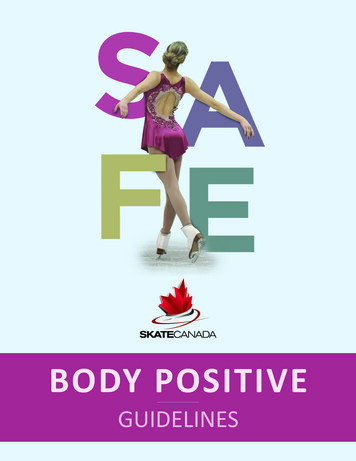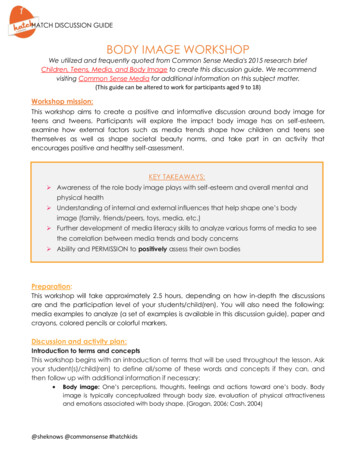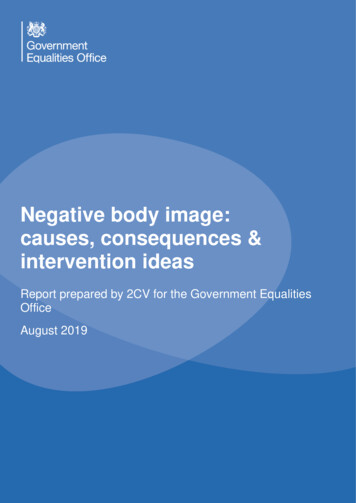
Transcription
My Body Belongs to MeA Child Personal Safety Education Tool KitFor Parents & TeachersPreschool to 6th GradeThis guide includes the following items: Brief description of the “My Body Belongs to Me” ProgramOutline of the 30 to 45-minute Children’s PresentationTips for teaching children personal safety skillsList of “What If” Role Plays to Test the Child’s KnowledgeMyth’s and Facts about Child Sexual AbuseSafety Planning with your ChildAdditional Resources/Information for Parents and TeachersFun ActivitiesThis program is administered by Interface Children & Family Services4001 Mission Oaks Blvd., Suite I, Camarillo, CA 93012For more information call (805) 485-6114, ext. 6911
Are you concerned about your child’s personal safety?Don’t be Afraid—Be Informed! Does your child know how to recognize potentially dangerous situations and people? Does your child know which “strangers” to ask for help if he/she were lost? Does your child know to tell you if an adult or older kid asks him/her to keep a secret? Does your child know that “secret touches” are not allowed between adults and children? Does your child know the 7 signals that give him/her the right to say, “NO!” GET AWAY andTELL a trusted adult? (See Seven Signals on page # 24-25).Your child will learn all of this with the “My Body Belongs to Me” program.The “My Body Belongs to Me” program teaches children about personal boundaries withoutmaking them afraid.The basic message is that, most people are good, but there are a few people who have a“touching problem” and if your child were ever confronted with this kind of person, they could“Say No,” “Get Away” and “Tell a Trusted Adult.”A 30-minute (Preschoolers to Kindergarteners) or 45-minute (1st to 6th Graders) presentation isconducted by a trained child-safety presenter from InterfaceChildren & Family Services in your child’s classroom, while in the presence of the regularclassroom instructor.Thank you for helping your child learn how to stay safe with theMy Body Belongs to Me Program!For more information call (805) 485-6114, Ext. 6912
My Body Belongs to MeChild Personal Safety education for your School!Children’s PresentationThe 30 to 45-minute classroom lesson focuses on engaging children through an interactive-learning approach,as they are taught that their body belongs to them and how to recognize and respond to NOT OK touches.Children can learn and practice when and how to say:“No”, Get away, and Tell a trusted adult helper.Our goal is to empower children as we teach them personal boundaries and ways they can seek help if theyshould encounter a dangerous person or situation. These are skills that help to prevent bullying, harassmentand child sexual abuse, in a non-threatening manner. The curriculum has been updated to age-appropriateworkshops that are tailored to fit the students’ social and developmental ability:o Preschool – 3rd Gradeo 4th – 6th GradeStaff Presentation:The 60-minute presentation introduces the program overview, while providing awareness and training foreducators. Topics include:ooooooooChild Sexual Abuse Awareness and PrevalenceStrategies on how to Prevent AbuseDevelopmental Behaviors of ChildrenSexual Behaviors in ChildrenTechniques for Effective Responses to Child Sexual BehaviorHow to Recognize Possible Signs of AbuseRefresher Piece on CA Mandated ReportingLocal Help and ResourcesParent Presentation:The 60-minute presentation includes a parental preview of the children's presentation, followed by aneducational workshop for parents and caregivers. Child personal safety topics include:oooooooooPreview of Children’s PresentationChild Abuse AwarenessTips to help Parents Prevent and ProtectHow to Recognize Possible Risky or Inappropriate BehaviorsPractice Personal Safety with ChildrenDevelopmental Appropriate Behaviors of ChildrenHow to Recognize Possible Signs of AbuseSafe Responses to Child Abuse DisclosuresLocal Help and Resources3
Child Personal Safety Videos“My Body Belongs to Me” VideoWritten by Jill StarishevskyAvailable to view on YouTube;http://www.youtube.com/watch?v a-5mdt9YN6INote: Children will only be viewing a partial piece of the video (2:10 minute mark)Español: http://www.youtube.com/watch?v KZ4cpmyoXbUOther Videos; “Mi Cuerpo Me Pertenece” – En EspañolDisponible para ver en YouTube:http://www.youtube.com/watch?v towuyzPXgUk&feature em-share video user “Check First”http://www.kidsmartz.org/Videos#checkfirst “Tell a Trusted dadult “Talk to an Adult you Trust”http://www.netsafeutah.org/kids/kids videos.html4
“My Body Belongs to Me” Chant:ME: “From the Top of My head”YOU: “From the Top of My head”ME: “To the bottom of my feet”YOU: “To the bottom of my feet”ME: “And everything else that’s in between”YOU: “And everything else that’s in between”ME: “MY BODY BELONGS TO ME!”YOU: “MY BODY BELONGS TO ME!”ME: “I have the right to protect my body”YOU: “I have the right to protect my body”ME: “I can say NO”YOU: “I can say NO”ME: “I can try to GET AWAY”YOU: “I can try to GET AWAY”ME: “And I CAN TELL!”US: “I can TELL!”ME: “When I don’t feel safe”US: “When I don’t feel safe”5
Tips for Teaching Children Personal Safety SkillsKeeping children safe and healthy is everyone’s responsibility.Children need to be taught that their bodies are their own, and that they have the right to say “NO” when itcomes to who touches them and whom they touch. If children are ever touched in way that is confusing orfrightening to them, they need to be taught that they can tell someone about the touch. They need to betaught that they have the right to feel safe and be safe. It is important that adults teach children to SAY “NO,”GET AWAY, and TELL A TRUSTED ADULT HELPER.The key to effective training is repetition and active rehearsal. Children need to practice saying no, getting awayand telling a trusted adult helper. While it is great to teach children that they have the right to “SAY NO, GETAWAY, AND TELL”, it should not stop there. All children are vulnerable and should not be held responsible fortheir own personal safety. Educating yourself, as well as other adults in children’s’ care, on bullying, child abuseand child sexual abuse prevention and awareness, is essential to the safety of all children.The following are additional tips that can help you teach effective personal safety to children:1. Assure children that most touches are OK touches and most people are good people. But if someonetouches their private parts in a secret way, or if they experience a touch that scares or confuses them,they can SAY “NO,” GET AWAY, and TELL SOMEONE. Remember that if children receive a NOT OK touchfrom someone they know or care about, like a relative or a babysitter, they may not be able to say “NO”or even get away. However, they can tell someone. Emphasize the importance of telling a helper and ifthe helper doesn’t believe them, keep on telling until someone listens and believes them. Let childrenknow it’s OK to question or challenge adults, when something doesn’t seem right, especially touches.Assure them that adults are not always right. Teach them there are things that adults should never do.2. Teach children the correct names for body parts. Just as they have arms and legs, they have a penis orvagina and anus. Children can’t tell you if they’ve received a NOT OK touch if they don’t have the wordsto describe the touch.3. Teach children how to use body language. Have them practice standing tall and saying “NO” in a loud,strong voice. Help children develop good eye contact.4. Play “what if” games with children. You can use the role-play scenarios found in the back of this packetor create your own. Develop “what if” situations that are pertinent to your own family. One of thepurposes of “what if” games is to stress to children the importance of always getting mom ordad’s/guardian’s permission before going anywhere.5. Show children safe places and people to go if they ever get lost; for example, a person behind a registerin a store. Have a written list of people who the child knows it is OK to go with. Share the list with thechild’s school, daycare and baby sitter. Stress to your child the importance of ALWAYS gettingpermission before going ANYWHERE with ANYONE, even if the person is known by you.These "Tips for Teaching Children Personal Safety Skills" are based upon information from Red Flag/Green FlagResource Center of Fargo/Moorhead6
“What If . . .”(Role Plays for Personal Safety)1. What if you are playing in your front yard when a person drives up and says, “Hi there, are you ready to go?Your dad sent me to pick you up and take you to his job. Your mom said it was OK. “What would you do?2. What if a person who is visiting your parents keeps coming into the bathroom and looking at you while youare taking a bath or shower. Since the lock on the door is broken, you can’t lock them out. What would you do?3. What if you are walking to school when a person drives up in a car and says, “Your mom or dad told me topick you up.” What would you do?4. What if you are playing at the park when someone walks up to you and says, “My puppy is lost. See, here’shis picture. Won’t you please come with me and help me find him before he gets hurt?” What would you do?5. What if a family member or family friend who often visits enjoys hugging you or having you sit on his/her lap?When he/she hugs you he/she also touches your private parts. What would you do?6. What if you are playing at the park and you see an older kid you don’t know standing by some trees. He/sheasks you to come over and talk to him/her. What would you do?7. What if you just got out of school. A person in a car says to you, “Your mom is late and she told me to pickyou up. Hop in the car.” What would you do?8. What if you are playing in your front yard when someone in a car drives up and says, “Hi there. I think I’m lostand I need some help. Can you please come over here and tell me where I am?” What would you do?9. What if you are playing in your front yard by yourself when someone in a car drives up and says, “Hi, can youcome over to the car? I have something for your parents.” What would you do?10. What if you are riding your bike and the chain falls off. A person comes out of his/her house and says he/shecan help you but you have to bring it into his garage. What would you do?11. What if a family member who you like always wants to wrestle. When you wrestle with him/her he/shetouches your private parts. What would you do?12. What if you are in a store looking at the toys. Someone you don’t know says to you, “Come outside to mycar with me and I’ll give you some money to buy that toy.” What would you do?13. What if your coach, teacher or youth group leader tells you they like you so much that they want to begin a“special” friendship with you that involves “special” touching that you have to keep secret. What would you do?These Role Plays are based upon information from Red Flag Green Flag Resource Center of Fargo/MoorheadAre there other Examples you and your child can think of?7
Myths and Facts about Child Sexual AbuseMyth #1: Child sexual abuse occurs only among strangers. If children stay away from strangers, they will not besexually abused. Fact: The National Department of Justice (DOJ) statistics indicate that in approximately 85% of the cases,the offender is known to the victim. He/she is usually a relative, family member, baby-sitter/other caregiver, or older friend of the child. About 10% of perpetrators of child sexual abuse are strangers to thechild.Myth #2: Children provoke sexual abuse by their seductive behavior.Fact: Seductive behavior is not the cause. Responsibility for the act ALWAYS lies with the offender. Sexualabuse sexually exploits a child not developmentally capable of understanding or resisting and/or whomay be psychologically or socially dependent on the offender.Myth #3: The majority of child sexual abuse victims tell someone about the abuse.Fact: According to a study by Dr. David Finkelhor, close to 2/3 of all child sexual abuse victims may not tell theirparents or anyone else because they fear being blamed, punished or not believed. Additionally, manyvictims feel that the abuse may be their fault in some way.Myth #4: Men and women sexually abuse their children equally.Fact: Men are the offenders 94% of the time in cases of child sexual abuse. Men sexually abuse both male andfemale children. 75% of male offenders are married or have consenting sexual relationships. Only about4% of same-sex abuse involves homosexual perpetrators; 96% of the perpetrators are heterosexual.Myth #5: If the children did not want it, they could say, “STOP!”Fact: Children generally do not question the behavior of adults, and have been taught to obey adults. They areoften coerced by bribes, threats, and use of a position of authority.Myth #6: All sexual abuse victims are girls.Fact: Studies on child sexual abuse indicate one of four females under the age of 18 and one of five to six malesunder the age of 18 are child sexual abuse victims.Myth #7: Family sexual abuse is an isolated, one-time incident.Fact: Studies indicate that most child sexual abuse continues for at least two years before it is reported. And inmost cases, it doesn’t stop until it’s reported.8
Myth #8: In family sexual abuse, the “non-offending” parent always knows.Fact: While some “non-offending” parents know and even support the offender's actions, many, because oftheir lack of awareness, may suspect something is wrong, but are unclear as to what it is or what to do.Myth #9: Family sexual abuse only happens in low-income families.Fact: Family sexual abuse crosses all classes of society. There is no race, social, or economic class that is immuneto family sexual abuse. Incest estimated to occur in 14% of all families. 10 to 20% of American childrenare incest victims; 90% of the victims are female, and 90% of the abusers are fathers or stepfathers.Myth #10: Non-violent sexual behavior between a child and an adult is not damaging to the child.Fact: Nearly all victims will experience emotional trauma such as confusion, shame, guilt, anger, and a poor selfimage. Child sexual abuse can result in long-term relationship problems and be perpetuated fromgeneration to generation. Dr. Nicholas Groth, who has worked extensively with sexual offenders, reportsthat 60% of convicted sexual offenders have reported histories of child sexual abuse victimization.Information provided by Red Flag Green Flag Resource Center of Fargo/Moorhead.9
Behaviors & IndicatorsWhile the presence of the following behaviors does not mean that a child has been sexuallyabused, a pattern of these behaviors usually indicates that a problem exists. It is important to talkwith a child who exhibits a pattern of behavioral problems and to seek any necessary help.1. Abrupt change in behavior2. Clinging, whining*3. Excessive fear of being touched4. Fear of being alone5. Refusal to go to a certain place or be with a certain person6. Nightmares or other sleep disturbances7. Regression to more infantile behavior such as wetting, thumb-sucking, fecal soiling*8. Change in appetite, eating disorders9. Excessive masturbation10. Developmentally inappropriate knowledge of sexual acts and sexual language*11. Precocious sex play such as attempts at sexual intercourse*12. Genital and rectal trauma, abrasions-may be evidenced by torn, stained, or bloody clothing13. Vaginal or uteral discharge, infection or sexually transmitted disease-often evidenced bydifficulty in urinating, scratching and tugging at clothing around genital area14. Unexplained gagging15. Withdrawal and isolation from peers16. Increase in physical complaints17. Acting out and attention getting behavior such as shoplifting, stealing, fire starting,physical aggression18. Depression, physical self-abuse, suicide attempts/threats19. School problems, truancy, drop in academic performance20. Prostitution or promiscuous sexual behavior21. Poor self-image-reflected in dress, cleanliness, appearance22. Alcohol/drug abuse23. Reluctance to undress for physical education classes24. Excessive bathing25. Pregnancy26. Attraction to older men or dislike of men27. Required to assume household and child care responsibilities28. Social activities have been unreasonably restricted29. Chronic running away(*Evident primarily in younger children)10
Do Children Lie About Sexual Abuse?1. Sexually abused children have been known to deny, minimize, “forget”, and confuse, butthey rarely lie. Research by Lucy Berliner (University of Washington) and colleagues inSeattle has matched children’s statements by sexual offenders and found that not onlywere the children’s statements accurate, but they often were found to be understatedaccounts of the abuse suffered.2. The reporting of sexual abuse is a developmental phenomenon. Children don’tautomatically report the way adults do. Their reports vary at different ages. For example,a very young child might not have the vocabulary or concept to express an abusive actcorrectly. “He peed in my mouth” is technically incorrect, yet graphically descriptive. Themanner in which children store and retrieve material also changes as they grow. Forexample, a child who is recalling details from incidents that occurred when he was four isattempting recall from a very different cognitive arrangement and even more differentfrom an adult’s way of thinking! These differences and inconsistencies might initiallyappear as “lies” but they are not.3. A well-documented phenomenon is the child’s suppression of his or her story right aftera child has reported it; this has been described and documented by Suzanne Sgroi, M.D.This phenomenon of admission and then denial can make an adult wonder if their storyis true; it is important to know and accept this aspect of a child’s reporting.4. Although with extensive prompting or interrogating children can be moved to recant oralter details about their stories, most often they rework details they are least clearabout, but usually remain adamant about central details.5. Children who have suffered multiple abuse encounters often present conflicting data,sometimes combining information from years of abuse into one or two accounts withapparently inconsistent details. The more often a child has been abused, the moreemotionally damaged he or she is. It often is precisely these children who give us clear,specific, consistent data that will stand up in court6. The criminal justice system has certain rules necessary for its functioning. Some of theserules don’t fit a child very well, nor do they take into account the normal differencesbetween a child’s and an adult’s cognitive structure and memory function. Only when achild’s statements can fit criteria of reliability and consistency can they be successful incriminal court. While a child’s inconsistencies may on the surface seem like lying, theyoften are normal for his or her age and developmental stage.11
7. The support of the child protection system by believing the child and his or her attorney,is critical to protect the child from the angry repercussions of accusers. If the system failsand the child is not protected, the best way for a victimized child to cope might be todeny one’s allegations and go back to life the way it was. Sadly, along with the risk offurther abuse comes the reality that the protection system no longer works either.8. Just because charges of alleged abuse have been dropped and children have recantedcertain statements, this does not indicate that children lie about sexual abuse. Whilecontroversy rages about whether to believe certain children, the children themselvescontinue to feel misunderstood and mistreated, heightening their sense of being victims.The most important thing that you can do for a child who is surviving sexual abuse is tolisten and believe the child and protect the child from further acts of abuse.12
Typical Sexual Behavior of Young ChildrenOften, sexual behavior in children is very disturbing to adults. Much of this behavior is part of normal childdevelopment. Behavior, which is typical for a child’s age, should be of little concern. Behavior, which is nottypical, can be a warning sign of abuse.Ages 0-4REDIRECT(It’s typical!)MONITOR(Not as typical, Slow down)PROTECTION(Not typical, ABUSIVE)Comfort in being nudePreoccupies themselves withsexual behaviorsDiscloses of sexual abuseTouches or rubs own genitals(randomly) or masturbatesopenlyMasturbates in preference toother activitiesCompulsively masturbates whichmay cause self-injury, or in apersistent nature or durationShows genitals, is interested,and/or explores the differencesbetween genitalsPersistently watches others in Demonstrates specific adult-likesexual activity, during toilet or sexual touches or sexual activities,bath times, or when nudefor example; imitates sexualintercourseShows an interest in body partsand their functionsExplicit sexual talk, art, and/or Persistently uses sexual themes inplaytalk, art, and/or playWants to touch familiarchildren’s’ genitals during play,toilet, or bath times (out ofcuriosity)Follows others into privatespaces like toilets orbathrooms to look at theirbody or touch themPersistently touches the genitals orprivate parts of othersParticipates in make believegames that involve looking atand/or touching the bodies offamiliar children, for example;“show me yours and I’ll showyou mine”, playing “family”,“house” and/or “doctor”.Pulls other children’s pantsdown or skirts up againsttheir will (displays power overthe other child by force)Forces other children to engage insexual activityAsks about or wants to touch the Touches the genitals/privatebreasts, bottoms or genitals ofparts of other children infamiliar adult, for example: when preference to other activitiesin the bath13Sexual behavior between youngchildren which involvespenetration with objects,masturbation of others, and/or oralsex
Children’s Sexual Behavior Guide for Personal SafetyAGES 5-9REDIRECT(It’s typical!)Increased sense of privacy aboutbodiesBody touching and holding owngenitalsMasturbation; usually withawareness of privacy.Curiosity about other children’sgenitals that involve looking atand/or touching the bodies offamiliar children; “show me yoursand I’ll show you mine”, playing‘family’Curiosity about sexuality likequestions about babies, gender,relationships, sexual activityMONITOR(Not as typical, Slow down)PROTECTION(Not typical, ABUSIVE)Masturbation inpreference to otheractivities; in public, withothers, and/or causingself-injuryExplicit talk, art, and/orplay of a sexual natureCompulsive masturbation; selfinjuring, self-harming, and/or to seekan audiencePersistent questionsand/or comments aboutsexuality, despite beinganswered or addressedPersistent nudity and/orexposing private parts inpublic placesPersistent bullying involving sexualaggression; pulling/lifting/removingother children’s clothingPersistently watching orfollowing others to look ator touch themAccessing the rooms of sleepingchildren to touch or engage in sexualactivityDisclosure of sexual abuseSexual behavior with significantlyyounger or less developmental-abledchildrenTelling stories or asking questions, Pulling other children’susing swear words, sexual wordspants down or skirts upor names for private partsagainst their willSimulation of or participation insexual activities such as; oral sex orsexual intercourse with olderchildren or adults.Use of mobile phones andinternet in relationships withknown peersPresence of a sexually transmittedinfectionPersistently mimickingsexual-flirting behavior,too advanced for age14
Children’s Sexual Behavior Guide for Personal SafetyAGES 10-13REDIRECT(It’s typical!)MONITOR(Not as typical, Slow down)PROTECTION(Not typical, ABUSIVE)Growing need for privacyMasturbation in preferenceto other activities in publicCompulsive masturbation; which maycause self-injury and/or seeking anaudienceMasturbation in privatePersistent explicit talk, art,or play which is sexual orsexually intimidatingEngaging others in a process to gainsexual activity by using groomingtechniques; gifts, lies, bribery, flattery,etc.Curiosity and seeking informationabout sexualityAccessing age restrictedmaterials; movies, games,internet with sexuallyexplicit contentForce or coercion of others into sexualactivityUse of sexual languagePersistent expression offear of sexually transmittedinfection or pregnancyOral sex and/or intercourse with aperson of different age, developmentalability and/or peer groupingInterest and/or participation ingirlfriend or boyfriendrelationshipsChanges to behavior, suchas older children or adultflirting behaviors, and/orseeking relationships witholder children or adults inpreference to peersPresence of sexually transmittedinfection or pregnancyHugging, kissing, and/oraffectionate touching that isappropriate, with known peersEngaging in sexual activitieswith an unknown peer;deep kissing, mutualmasturbation, etc.Deliberately sending and/or publishingsexual images of self or another personExposing themselves amongstsame age peers within thecontext of play; for example,occasional flashing or mooningOral sex and/or intercoursewith a known partner ofsimilar age anddevelopmental abilityArranging a face to face meeting withan online acquaintance15
Typical Stages of Sex Play2 ½ Years:Child shows interest in different postures of boys and girls when urinating andinterest in physical differences between the sexes.3 years:Verbally expresses interests in the physical differences between the sexes and inthe different postures in urinating. Girls attempt to urinate standing up.4 years:Extremely conscious of the navel. Under social stress may grasp genitals and mayneed to urinate. May play game of “show”. Also, verbal play about elimination.Interest in other people’s bathrooms, may demand privacy for self, but extremelyinterested in the bathroom activity of others.5 years:Familiar with, but not too much interested in the physical differences between thesexes. Less sex play and game of “show”. More modest and less exposing self. Lessbathroom play and less interest in unfamiliar bathrooms.6 years:Marked awareness of and interest in differences between the sexes in bodystructure. Questioning mutual investigation by both sexes reveal practical answersto questions about sex differences. Mild sex play or exhibitionism in play or inschool toilets. Games of “show”. Giggling, calling names or remarks involvingwords dealing with elimination functions.7 years:Less interest in sex. Some mutual exploration, experimentation, and sex play, butis less than earlier.8 years:Interest in sex rather high, though exploration and play less common than at six.Interest in peeping, dirty jokes, provocative giggling. Children whisper, write orspell “elimination” or “sex” words.9 years:May talk about sex information with friends of the same sex. Interest in details ofown organs and functions; seek out picture books. Sex swearing begins.10 years:Considerable interest in dirty jokes.16
Child Safety: Internet ConcernsWhen used properly, the Internet can be a wonderful learning and entertainment tool for you and your family. Inmany ways, the virtual world of the Internet is like that of the real world. Similar safety rules apply. Just as youwouldn’t tell a stranger on the street where you live, you shouldn’t tell someone you just met on the internetyour home address. Before allowing your children online, discuss with them safety issues. Talk to them about yourconcerns and together set up family guidelines for computer use. Here are some ideas to keep in mind. Help your children to understand why it is important that they do not give out personal information,even if their new e-mail pal seems to be real friendly or a “cool” website offers them a free gift for theinformation. Let your children know that they can come to you if they are receiving messages that make them feeluncomfortable. Tell them that in such an event, they should save the messages for you to read andhandle in an appropriate manner. Set up guidelines that deal specifically with meeting people on the Internet. Talk to your children aboutwhat to do if their new Internet friend asks to see them in person, or wants your children to sendpictures of themselves. Teach children about “netiquette” (etiquette on the Internet), so that they will not accidentally offendsomeone. Keep the computer in high traffic part of the house such as the living room. You can then easily monitoryour children’s activities without making them feel as if you are watching over their shoulder all thetime. Find websites you think your children will enjoy and “bookmark” them. This will help direct your childrenaway from using search engines, where they might find inappropriate sites. Most importantly, spend time with your children talking about their experiences online. Give them achance to show you what they have learned or the things they like.Helpful Websites on Child Personal Safetywww.netsmartz.org: sponsored by The National Center for Missing and Exploited Childrenhttps://www.childhelp.org: A non-profit organization dedicated to the prevention and treatment of child abuse.http://www.stopitnow.org: Stop It Now! Organization prevents the sexual abuse of children by mobilizingadults, families and communities to take actions that protect children before they are harmed.www.netsmartzkids.org: for kids a safe site that won’t link to any outside sourceswww.connectsafely.org: for information on smart social networkingwww.internetsafetycolorado.org: for information on smart social networking and internet use.http://www.kidsdata.org/ a program of the Lucile Packard Foundation for Children's Health, promotes thehealth and well-being of children in California.17
Children’s Entertainment: Making Good DecisionsParents everywhere
they can SAY “NO,” GET AWAY, and TELL SOMEONE. Remember that if children receive a NOT OK touch from someone they know or care about, like a relative or a babysitter, they may not be able to say “NO” or even get away. However, they can tell som











